Where are the fires in Tenerife? Map of Spain wildfires and the latest travel advice as evacuation continues
An out-of-control wildfire on the Spanish Canary island of Tenerife has burned thousands of acres of land and forced 8,000 people to either evacuate from, or be confined in their homes.
Regional president, Fernando Clavijo, said some 250 firefighters and members of the Spanish army were tackling the blaze on Thursday.
“This is probably the most complicated blaze we have had on the Canary Islands, if not ever, in at least the last 40 years,” he told reporters. He said extreme temperatures on the island added to “specific meteorological conditions” caused by the fire that turned the area into a virtual oven.
Where are Tenerife wildfires?
The main fire located in the north of the island, which is very popular among tourists. Mr Clavijo said the fire had a perimeter of almost 30 kilometres.
The blaze, which started on Tuesday night, is centered on a craggy, mountainous area, which is difficult for emergency brigades to access. Spanish authorities said their main goal is to contain the fire and prevent it from reaching more populated areas. The island’s main town, Santa Cruz, is 20 kilometres (12 miles) away from the flames.

The wildfire is threatening six municipalities. Some 7,600 residents in the area have either been evacuated from their homes or ordered to stay indoors due to hazardous air quality. Mr Clavijo said firefighters were working day and night but the fire remained “out of control”.
The fire could become Spain’s worst of the summer so far, as the country suffers another year of severe drought.
More than 2,000 people were evacuated due to a wildfire on the nearby island of La Palma last month that affected some 4,500 hectares (11,000 acres).
Wildfires have burned almost 64,000 hectares (158,000 acres) in Spain so far this year, according to Spanish government data – the third highest figure in the last decade.
Is it safe to travel to Tenerife?
The Tenerife tourism office stressed in a statement on Thursday afternoon that the main tourist areas and cities of the island are away from the fire.
Business continues as usual in accommodation establishments, beaches and other tourist sites located in areas near the coast and in the midlands, the office said.

But access to the Teide National Park, the most important tourist attraction in Tenerife after the beaches, closed to the public on Thursday at 6pm local time, said the Canary regional government. All tourist facilities around the Teide volcano area are being evacuated, including accommodation of the astrophysics institute of the Canary Islands.
Temperatures in the Canary Islands peaked at more than 40ºC in recent days, and are set to rise again on Saturday, so tourists should be aware of how to stay safe in the heat.
It is good practice to carry high-SPF sunscreen and a bottle of water with you at all times, applying and refilling throughout the day. Avoid drinking too much caffeine or alcohol in hot weather, too, as this will dehydrate you faster.
If you can, avoid strenuous activity in the middle of the day (around midday to 5pm), when temperatures are highest.
The following symptoms, outlined by the NHS, could be signs that you are suffering from heat exhaustion:
- tiredness and/or weakness;
- dizziness;
- headache;
- feeling sick or being sick;
- excessive sweating or a heat rash;
- cramps in the arms, legs and stomach;
- fast breathing or heartbeat;
- a high temperature;
- extreme thirst.
If so, move out of the sun and into the shade as quickly as possible, keeping cool with water or sports drinks. Remove any unnecessary clothes and place cold packs or cold, damp towels around the neck, under the armpits or around the feet to help bring the body temperature down.
If left untreated, heat exhaustion can turn into heatstroke, a serious condition that may require medical attention. For more information on keeping cool in hot weather, visit the NHS website.



